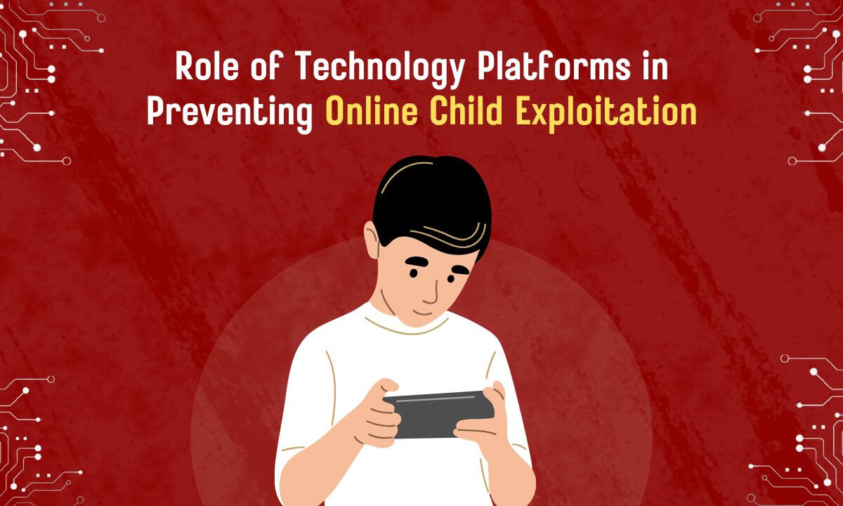Discover how tech platforms are helping prevent online child exploitation through AI detection, safety tools, and law enforcement collaboration.
“The internet can either be a playground or a predator’s hunting ground. Tech platforms must decide which.”
INTRODUCTION
As children spend more time online for education, entertainment, and social connection, the risks of online child exploitation—including grooming, sextortion, and trafficking—have grown alarmingly. India, with its vast youth population and booming internet penetration, faces a dual challenge: keeping children connected and protected.
While legal frameworks like the POCSO Act and Information Technology Act provide some safeguards, it is technology platforms—from social media giants to messaging apps—that hold the tools to detect, disrupt, and deter abuse in real time.
This blog explores how digital platforms are evolving to protect children, and what more needs to be done to make the internet a safer space for the youngest users.
AI-Powered Detection of Exploitative Content
One of the most powerful tools tech platforms use to prevent abuse is Artificial Intelligence (AI). AI systems can:
- Detect Child Sexual Abuse Material (CSAM) in images, videos, and messages.
- Identify grooming behavior through language pattern analysis.
- Flag suspicious user activity—such as adults attempting to connect with many minors.
Google’s Content Safety API and Microsoft’s PhotoDNA are leading technologies used by platforms to scan for and block known abusive content. Instagram and Facebook also deploy machine learning algorithms to remove CSAM and prevent live-streamed abuse.
End-to-End Encryption for Child Safety
End-to-end encryption offers privacy but complicates monitoring. Apps like WhatsApp and Signal are under pressure to balance privacy with child safety. Some solutions under development include:
- Client-side scanning, which flags harmful content before it’s encrypted.
- Age verification and parental control integrations, without breaking encryption.
The debate continues worldwide, with tech companies, lawmakers, and child rights groups trying to find middle ground. The Internet Watch Foundation (IWF) advocates for innovation in secure scanning that respects both privacy and safety.
Proactive Reporting and Takedown Mechanisms
Technology platforms are now required by law in many countries to report CSAM to relevant authorities. In India:
- The Cyber Crime Reporting Portal (https://cybercrime.gov.in) allows users to report online child abuse.
- Companies are encouraged to share data with the National Crime Records Bureau (NCRB) and Interpol for coordinated takedown operations.
Many platforms work with INHOPE, a global network of hotlines, and actively collaborate with agencies like NCMEC (National Center for Missing & Exploited Children) in the U.S.
Platform-Specific Safety Features
Each major platform has introduced child protection tools to prevent online exploitation:
YouTube:
- Restricted Mode to block mature content.
- AI to detect and disable comments on videos featuring minors to prevent predatory behavior.
Instagram:
- Alerts when adults attempt to message minors who don’t follow them.
- Proactive safety messages encouraging minors to be cautious.
TikTok:
- Family Pairing Mode to allow parents to control screen time, messages, and content.
- Blocking underage users from direct messaging altogether.
Meta (Facebook & Messenger):
- Age-specific settings and automatic privacy defaults for users under 18.
- Prompts on risky behavior or harmful interactions.
Collaborations with NGOs and Governments
To ensure culturally sensitive and legally compliant responses, tech platforms increasingly work with:
- NGOs which help flag and remove exploitative content.
- Government stakeholders, especially under initiatives like the Digital India programme and Cyber Crime Prevention against Women & Children (CCPWC).
In 2022, Google India partnered with Cyber Peace Foundation to launch cyber safety awareness campaigns in schools, reaching over 100,000 students.
Empowering Users Through Education
No algorithm can replace informed users. That’s why platforms also:
- Create child-focused safety hubs and guides.
- Run in-app education campaigns about online grooming and sextortion.
- Provide tools like block/report, digital wellbeing dashboards, and emergency helplines.
What More Can Be Done?
Despite major steps, gaps remain:
- Age verification is still weak across platforms.
- Dark web exploitation remains outside the reach of most tech solutions.
- Smaller platforms, gaming forums, and chat apps often lack robust safety protocols.
India needs unified regulation through a Digital Child Safety Code, ensuring all platforms—big or small—meet minimum safety standards.
CONCLUSION
Technology platforms are no longer passive channels—they are gatekeepers of safety. With AI, partnerships, and policy compliance, they can turn the internet from a hunting ground into a safe, vibrant space for young minds. But to do so, they must prioritize safety by design, not as an afterthought.
In case you are looking for customized child safety training, POCSO-related training, or POCSO advisory services, please feel free to reach out to us at +919004521614 or [email protected].
Authored by Tanvi Ojha, Content Writer Intern


 Cart is empty
Cart is empty 
